
Headless CMS scales and improves WPWhiteBoard’s content distribution, flexibility, and personalization
Aniket Ashtikar
Your business has a clear path to global expansion, but the technology meant to enable it is holding you back. Once effective for a single market, your traditional content management system (CMS) has become a bottleneck.
Every new country, language, and currency adds an exponential layer of complexity.
Development cycles are painfully slow, costs are spiraling, and your marketing teams are handcuffed, unable to create the truly localized experiences needed to win in new regions.
The goal of seamless scalability feels impossible.
A headless CMS solves global scaling challenges by decoupling content from the presentation layer, eliminating channel-specific bottlenecks.
This architecture enables you to centrally manage all multilingual content while delivering perfectly adapted user experiences to any region, device, or platform.
Move beyond basic definitions to a definitive business case, strategic framework, and implementation roadmap for using a headless CMS to transform your content operations.
Know how to turn localization from a painful cost center into a powerful revenue driver, making your choice of CMS a true competitive advantage.
As a technology leader, you do not just manage systems; you enable business strategy. When your core content platform actively works against your company’s global ambitions, you have a strategic problem, not just a technical one.
The traditional, monolithic CMS is a relic of a simpler era, and its architectural limitations are the source of your deepest frustrations.
Your traditional CMS was designed with a single website in mind. Its content (the "body") and presentation (the "head") are fused into one tightly coupled system, creating an architectural prison.
If you want to launch a new microsite for the Japanese market, you often must spin up an entirely new, costly instance of the CMS.
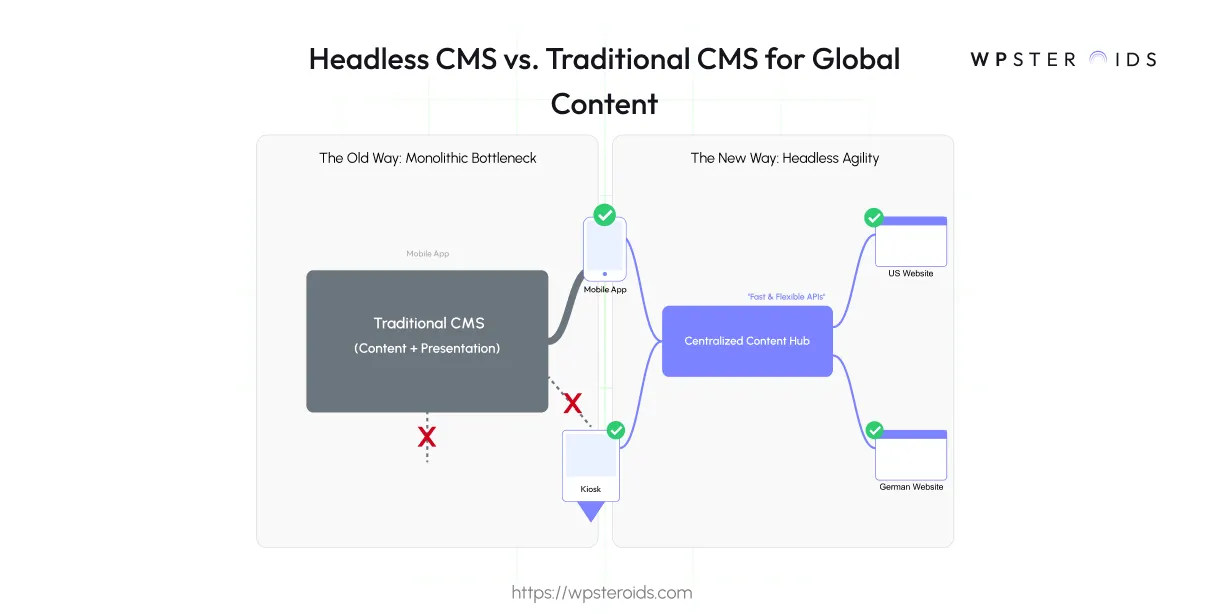
If you need to push a product description to a mobile app, a partner portal, and an in-store kiosk, each channel requires custom development because the content is locked inside your website's templates.
This monolithic approach is brittle and slow. Every change is a risk, and scaling is a matter of brute force—more developers, more time, and more money.
In today's market, where customers expect seamless, culturally relevant experiences on every device, this model is unsustainable.
You need a content internationalization strategy that is agile and future-proof, not one that adds technical debt with every new border you cross.
Migrating to a headless architecture is more than a software change. It is a fundamental shift in how your organization thinks about, creates, and distributes content.
Leaders who grasp this see the most significant gains because they understand that the technology serves a more agile and powerful operational model.
This new mindset unlocks the full potential of your content internationalization strategy.
If you evaluate headless CMS platforms on feature lists alone, you are missing the most important part of the equation.
While many vendors focus on technical features, the real strategic advantage lies in how a headless CMS empowers your company to adopt modular content modeling.
The conversation should not be about just managing translations, but about fundamentally restructuring content. Forget thinking in terms of monolithic pages. Instead, think in small, reusable, and context-agnostic "chunks."
A product description, a customer testimonial, a hero banner, a legal disclaimer—each becomes a standalone block of content that can be pulled into any experience, on any channel, at any time.
This is the operational shift that unlocks speed and scalability.
This approach, known as multilingual content modeling (as seen with Contentful CMS), means you update a testimonial once, and it populates everywhere. You translate a product feature once, and it is ready for the website, mobile app, and partner portal simultaneously.
Your teams no longer rebuild pages; they assemble experiences from a library of pre-approved, on-brand components.
The CMS is merely the enabler; the modular strategy is the revolution.
This "decoupled" or "modular" strategy can feel abstract. Let's make it concrete.
Think of your content as being prepared in a central, five-star restaurant kitchen (the headless CMS). This kitchen does not have its own dining room. Instead, it prepares and perfects core ingredients and dishes (your content).
These dishes can then be delivered to and served by a fleet of specialized food trucks (your website), fine-dining pop-ups (your mobile app), and even airline caterers (IoT devices like smartwatches).
Each "truck" can add its own local flavor—like extra spice for the Mexican market or different packaging for the Japanese market—without ever going back to change the master recipe in the central kitchen.
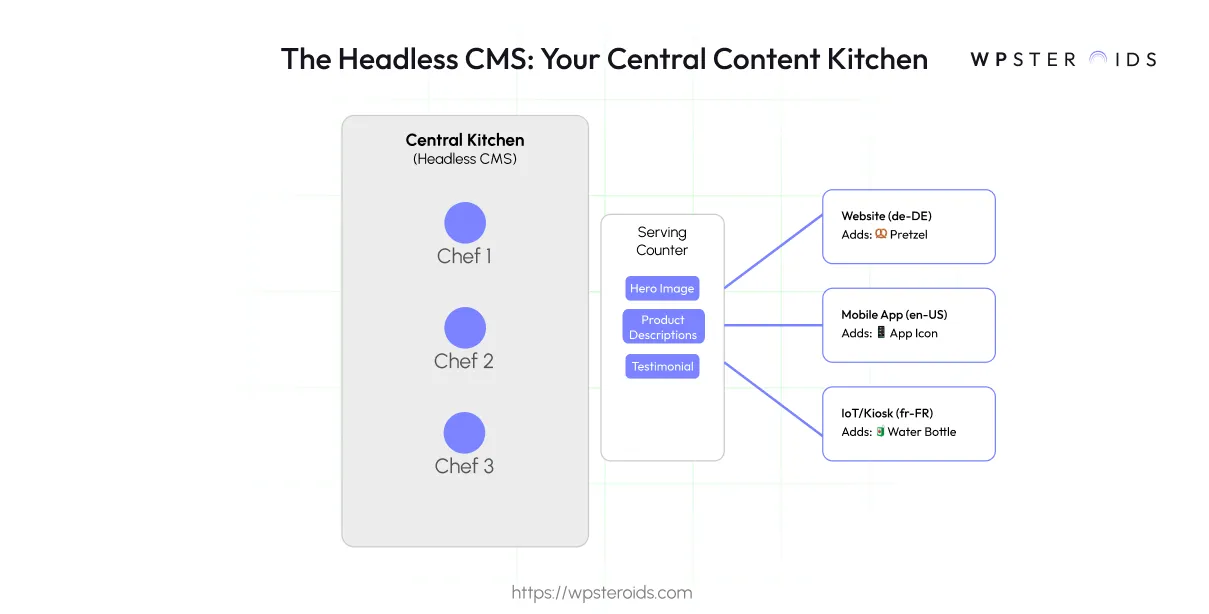
This is the power of headless localization:
Translation is a one-to-one conversion of words. Localization is the holistic adaptation of an entire experience—from images and date formats to cultural references and payment options—to feel native to a specific market.
A traditional CMS struggles with this because it treats content as a single, static page that must be translated. A headless CMS, by its nature, is designed to handle this complexity with elegance and efficiency.
In an old CMS, adding a new language often means installing a clunky plugin that adds a new text field next to the original. This is not true multilingual support; it is a patch.
A purpose-built headless CMS for multiple languages handles this at its architectural core. Instead of thinking in terms of "original" and "translated" fields, it thinks in terms of locales.
A locale is a specific combination of language and region (e.g., en-US for American English, fr-CA for Canadian French).
Your modular content blocks can have different versions for each locale you target. This goes beyond words.
For the en-US locale, a field might call for an image of a baseball game; for en-GB, the same field can be populated with an image of a cricket match.
This granular control allows you to adapt every component of an experience, ensuring it is truly resonant, not just understood.
Your content team members are experts in creating compelling narratives. Your translators are language experts. A headless CMS does not try to replace either; it orchestrates the process. This is where its API-first design becomes a massive advantage.
Instead of clumsy, manual hand-offs where content is copied and pasted into spreadsheets, you can create seamless translation workflows.
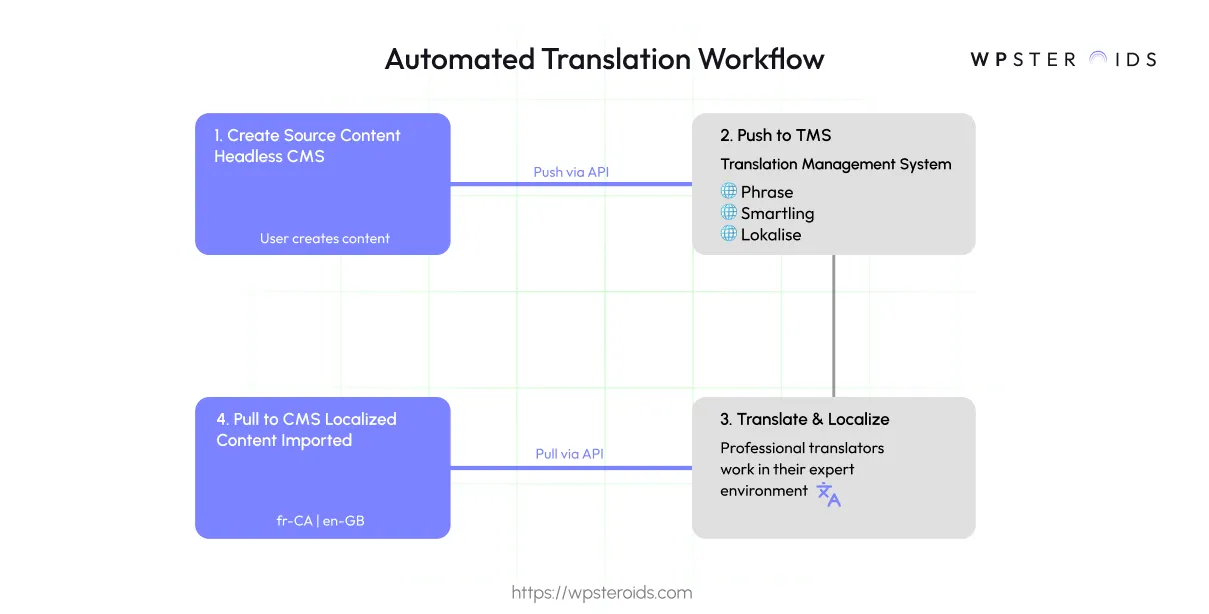
The process typically looks like this:
How do you give regional marketing teams the autonomy to create locally relevant campaigns without diluting your global brand? This classic challenge is made worse by monolithic systems.
The headless model solves this by separating the source of truth from the point of delivery. All your core, approved, on-brand content modules live in one central repository.
Your teams in Germany and Brazil build their local experiences from the same set of approved building blocks.
They can choose which blocks to use and how to arrange them, and they can populate them with content from their specific locale (de-DE or pt-BR), but they cannot create rogue, off-brand components.
This ensures your brand voice, key messaging, and visual identity remain consistent worldwide, even as the final experience is perfectly tailored to each market.
For too long, localization has been viewed as a necessary evil—a line item on the budget. This fundamentally misunderstands its power.
When done right, localization is a direct driver of revenue and market share. The goal is not just to translate words; it is to build trust and connection with new audiences.
A modern localization CMS makes this possible at scale. The business impact is clear and quantifiable.
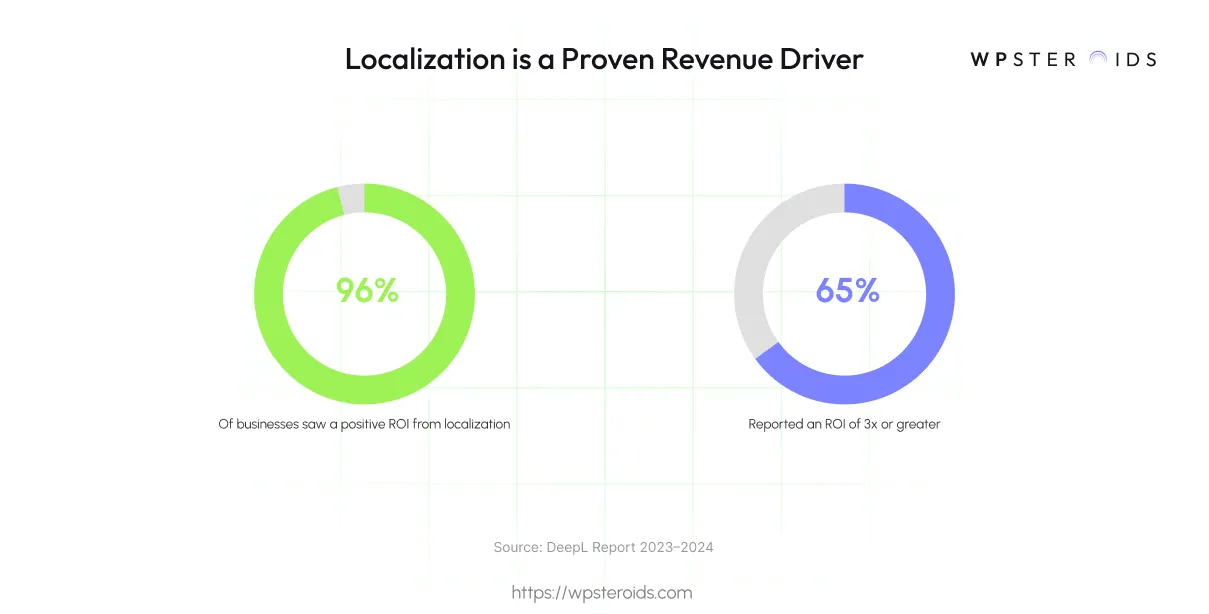
This is not just about avoiding mistakes; it is about seizing an opportunity. By decoupling your content from the presentation layer, a headless architecture gives your teams the freedom to execute.
Whether for a global website or a targeted headless commerce localization push, you can stop spending your budget on duplicative development and start investing in experiences that resonate, convert, and build lasting brand loyalty in every market you enter.
Once you embrace the modular content mindset, your focus shifts to the enabling technology. Not all headless platforms are created equal, especially for the demands of global scale.
Evaluating the right headless CMS for global sites requires looking past marketing buzz and focusing on the core architectural features that will either accelerate or inhibit your growth.
For a robust international strategy, these features are non-negotiable.
This is the technical heart of headless localization. Locale-aware content fetching means your front-end application can ask the CMS for content for a specific locale, and the CMS will deliver just that version.
For example, when a user from France visits your website, the site's code makes a single, clean API call asking for the fr-FR version of the homepage content.
The headless CMS responds with only the French text, the images selected for the French market, and prices in Euros.
This is incredibly efficient. It eliminates the need for your front-end developers to write complicated, brittle code to sift through multiple languages and piece together the right experience.
This simplifies development, boosts performance, and is a foundational element of proper language support.
When multiple teams work across different time zones and languages, control becomes paramount.
A simple mistake can go live in a key market and damage brand perception or even create legal exposure. That is why robust versioning and governance are critical.
You need a system that provides a clear audit trail for every piece of content. Who changed the product description for the UK market? When was it published?
If you discover an error, can you instantly roll back to a previous, approved version with a single click?
Furthermore, you need to set up custom workflows. For instance, a junior content editor on the LATAM team might be able to create content, but it must be approved by a regional manager before it can be published.
This combination of version history and customizable permissions provides the safety net you need to empower your teams while protecting your brand.
This code tells search engines like Google which language and regional version of a page to show a user.
Managing hreflang tags manually is a recipe for disaster. The best headless CMS for internationalization solves this by managing these relationships for you.
When you link the en-US version of a product page to its de-DE counterpart in the CMS, the system should automatically handle the hreflang tagging on the backend.
It should also provide distinct fields for localized metadata—SEO titles, meta descriptions, and social sharing text—for every locale, ensuring you fully optimize your search visibility in every market.
This brings us back to the core idea that localization is more than just words. True cultural adaptation requires flexibility in your content structure. Your CMS must allow you to create content models that account for these differences.
For example, a "product" content model should not just have a text field for the "description." It must include:
This level of flexibility allows your teams to adapt not just the language but the entire substance of the content to fit local norms and expectations, creating a truly authentic and effective user experience.
Of course. Here is that section, written to provide direct, comparative value to a leader evaluating their options.
While many headless platforms support multilingual content, the best headless CMS for internationalization provides dedicated features that streamline the entire workflow, from translation to delivery.
The right choice depends entirely on your team's structure, technical resources, and strategic priorities.
Here’s a direct comparison of the leaders to help you decide.
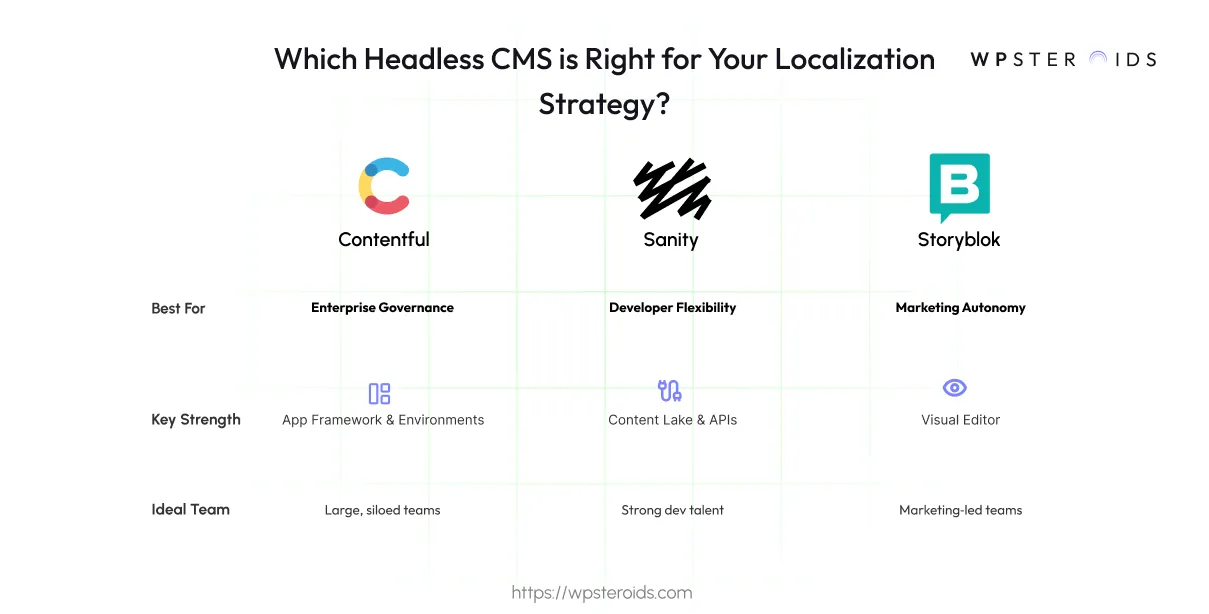
Best for: Large organizations and enterprise teams that require robust governance, security, and predictable release cycles across many regions.
Contentful is a true heavyweight in the headless space, and its strengths shine in complex corporate environments.
For localization, its power lies in the App Framework, which allows for deep, seamless integrations with virtually any Translation Management System (TMS).
This isn't just a simple webhook; it's a configurable two-way street for your content.
Furthermore, its sophisticated environment management (e.g., development, Q&A, production) allows your teams to safely build and test localized experiences without risking the live site.
If control, security, and managing multiple teams across a large portfolio of headless CMS for global sites is your primary concern, Contentful is built for you.
Best for: Teams with strong development talent who need to build a completely bespoke content solution tailored to unique business logic.
Sanity treats your content as data in its "Content Lake", giving developers unparalleled flexibility. This makes it an exceptional open-source headless CMS with localization at its foundation.
Instead of being confined to pre-defined localization features, your developers can build the exact translation workflow you need. Do you need to link three different content types based on a regional product launch? Do you have a custom-built translation tool?
Sanity’s open structure and powerful APIs allow you to build those workflows from the ground up. This is the choice for leaders who see their content as a core part of their technology stack and want to avoid any platform constraints.
Best for: Organizations where marketing and content teams need to see their work in a real-world context to feel confident and move quickly.
Storyblok’s killer feature is its real-time visual editor. It brilliantly solves one of the biggest usability challenges of headless architecture. While editing, your team sees a live, clickable preview of the website or application right next to the content fields.
When they switch from the en-US locale to de-DE, the text, images, and even layout components update instantly in the preview. This is a game-changer for regional marketers who aren't developers.
It eliminates the guesswork and the endless cycle of "publish, review, fix, republish", empowering them to craft culturally relevant experiences with speed and autonomy.
Adopting new technology and a new content strategy is a significant undertaking.
While the benefits of headless localization are transformative, the path has potential pitfalls. Being aware of these common challenges is the first step to mitigating them.
Here is a pragmatic look at the top five hurdles and how to clear them.
We have moved from the frustrating bottlenecks of a traditional system to the strategic clarity of a modern global content operation. The path forward is not about buying a new tool, but adopting a new mindset.
The shift to modular content, enabled by a headless CMS, is the key to breaking through complexity. It all comes down to one core idea: The CMS is the enabler; the modular strategy is the revolution.
This approach transforms your content from a static liability into a dynamic asset, finally aligning your technology with your ambition. It is how you turn global expansion from a source of friction into an engine for revenue.
Ready to stop wrestling with your technology and start winning in new markets?
Book your discovery call today. Let's discuss your specific challenges and map out how a headless architecture can transform your global content strategy from a cost center into your biggest competitive advantage.
